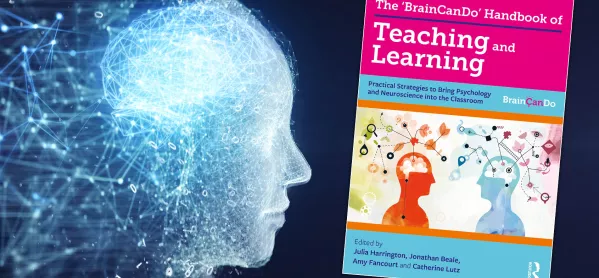- Home
- Book review: The BrainCanDo Handbook
Book review: The BrainCanDo Handbook

The BrainCanDo Handbook of Teaching and Learning
Edited by: Julia Harrington, Jonathan Beale, Amy Fancourt and Catherine Lutz
Publisher: Routledge
Details: 263pp; £19.99
ISBN: 978-0367187057
Prince Harry has reported how he has learned a huge amount about unconscious bias since being married to Meghan Markle. In a moment of honesty, he recalled that he had been raised in a context of luxury and privilege, and it had taken him many years to recognise his own prejudices.
This prejudice, or unconscious bias, creeps in whether we like it or not. We are born with a predisposition to prefer the sorts of people we are familiar with, and this colours our behaviour and attitudes towards others.
What has this got to do with a review of a book about the translation of educational neuroscience into teaching and learning practice?
Just as Prince Harry has come to realise, in order to understand anything with any nuance, it is necessary to become more familiar with the background and context from which it came. Rigorous research always makes strenuous attempts to acknowledge any possible bias that may limit the findings of the study - no study is ever perfect, and it is important that we understand that.
Challenging scientism and scepticism
One limitation we should always consider is the demographic make-up of the participants. It goes without saying that we would be suspicious of using a new drug that had been tested only in a laboratory in a test tube, under perfect conditions. We would expect the drug to have been applied to a normal, varied group of people, going about their lives in the everyday world before we used it.
The BrainCanDo Research Centre is based at Queen Anne’s School, a small, selective independent girls school, in Berkshire. In collaboration with other schools, including Eton and Westminster City School, the research centre has embraced the opportunity to run research studies with respected researchers, developing approaches to implementing educational neuroscience. At the same time, it is also challenging the scientism and scepticism they perceive across the education sector.
Undoubtedly, the book is an impressive collection of pieces, written by teachers in partnership with researchers exploring the latest research in educational neuroscience and psychology, and offering practical strategies for its application in secondary schools.
The chapters vary. Some provide careful, scholarly, impressively referenced reviews of the literature, followed by suggestions of how these findings could be translated into practice and evaluated.
In other cases, the weighty and erudite literature review acts as background to the description of a serious, well-funded and systematic research study constructed to document new practices and evaluate impact.
Swayed by the use of scientific language
Refreshingly, the book starts with a philosophical exploration of the elusive concept of scientism: the dogmatic excessive belief in the power or value of science. We have, it suggests, “a dogmatic assumption that scientific methods or findings can be immediately or straightforwardly applied in education”. This is where schools and practitioners are misled.
We are wrong to consider it easy or to be easily swayed by the use of scientific language or concepts. It is perfectly possible to be a good teacher without a deep knowledge of educational neuroscience.
The main finding of this chapter is that we should be cautious, and recognise the limitations of science and how far the findings can be translated into messy, educational contexts. We should be aware of using scientific or quasi-scientific language to try to make work look more impressive.
The bulk of the book explores the familiar canon of educational neuroscience, including subjects such as executive function, cognitive-load theory and working memory, misconceptions and counterintuitive concepts in maths and science, growth-mindset theory and the importance of sleep.
There is a chapter describing a longitudinal study of girls at Queen Anne’s as they engaged in their “high-quality musical learning and instruction” over a year, and the impact and importance this may have on cognitive and social and emotional learning.
We read how Eton College developed a curriculum designed to build character in their pupils, including opportunities for the boys to volunteer in the local community to enable them to “develop empathy and be more concerned with those not within their social circles” (remember Prince Harry?).
A very distant reality
Undeniably, the work they have accomplished is deeply impressive. The opportunities they have created for their staff to work on research projects with researchers of international standing is admirable and there is much we can draw from their descriptions of gains in learning their students have made.
But the world they describe is a very distant reality to the one most teachers and leaders face during these dark and challenging times. Perhaps we might consider it a description of the test tube of perfect conditions, where the participants have every available luxury and privilege.
So, while I recognise their deep commitment to the study of the translation of evidence into practice and their interest and dedication to the subject, I am acknowledging the limitations of their research. In essence, this is not a book for the everyday, workaday, comprehensive teachers and leaders among us.
The takeaway for those of us struggling to secure enough digital equipment to enable all our pupils to access remote learning might just be: look what you could do if you had the money and time to do so.
It is, perhaps, a glimpse into how the others believe they can do these things better - with a dose of educational neuroscientism thrown in.
Megan Dixon is director of research and development at the Aspire Educational Trust
Keep reading for just £1 per month
You've reached your limit of free articles this month. Subscribe for £1 per month for three months and get:
- Unlimited access to all Tes magazine content
- Exclusive subscriber-only stories
- Award-winning email newsletters



